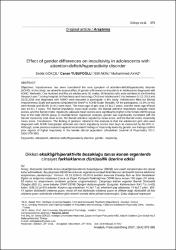| dc.contributor.author | Gökçe, Sebla | en_US |
| dc.contributor.author | Yusufoğlu, Canan | en_US |
| dc.contributor.author | Akın, Elif | en_US |
| dc.contributor.author | Ayaz, Muhammed | en_US |
| dc.date.accessioned | 2019-07-22T11:33:05Z | |
| dc.date.available | 2019-07-22T11:33:05Z | |
| dc.date.issued | 2017 | en_US |
| dc.identifier.citation | Gokce, S., Yusufoglu, C., Akin, E., & Ayaz, M. (2017). Effect of gender differences on impulsivity in adolescents with attention-deficit/hyperactivity disorder. Anadolu Psikiyatri Dergisi-Anatolian Journal of Psychiatry, 18(4), 379-386. | en_US |
| dc.identifier.issn | 1302-6631 | |
| dc.identifier.uri | https://hdl.handle.net/20.500.12294/1572 | |
| dc.description | Ayaz, Muhammed (Arel Author) | en_US |
| dc.description.abstract | Objective: Impulsiveness has been considered the core symptom of attention-deficit/hyperactivity disorder (ADHD). In this study, we aimed to assess effect of gender differences on impulsivity in adolescents diagnosed with ADHD. Methods: One hundred and fifty-six adolescents (91 males, 65 females) who were admitted to the Erenkoy Research and Training Hospital for Psychiatry and Neurology Child and Adolescent Clinic between 01.01.2016 and 01.05.2016 and diagnosed with ADHD were recruited to participate in this study. Adolescents filled out Barratt Impulsiveness Scale and parents completed the SNAP IV ADHD Scale. Results: Of the participants, 41.6% (n= 65) were female and 58.3% (n=91) were male. The mean age of girls was 14.3 +/- 1.7 years, and the mean age of boys was 14.4 +/- 1.7 years. The Barratt impulsivity mean total scores, the Barratt attentive impulsivity subscale mean scores, and the Barratt motor impulsivity subscale mean scores were significantly higher in the female ADHD group than in the male ADHD group. In multiple linear regression analysis, gender was significantly correlated with the Barratt impulsivity total mean score, the Barratt attentive impulsivity mean score, and the Barratt motor impulsivity mean score. Conclusion: The finding of greatest interest in this analysis is that the adolescent girls who were diagnosed with ADHD had greater attentive and motor impulsivity scores than boys as measured by the BIS-11. Although, some previous research reported inconsistent findings of impulsivity levels by gender, our findings confirm prior reports of higher impulsivity in the female clinical population. | en_US |
| dc.language.iso | eng | en_US |
| dc.publisher | Cumhuriyet Univ. | en_US |
| dc.relation.ispartof | Anadolu Psikiyatri Dergisi-Anatolian Journal of Psychiatry | en_US |
| dc.rights | info:eu-repo/semantics/openAccess | en_US |
| dc.subject | Adolescent | en_US |
| dc.subject | Attention-Deficit/Hyperactivity Disorder | en_US |
| dc.subject | Gender | en_US |
| dc.subject | Impulsivity | en_US |
| dc.title | Effect of gender differences on impulsivity in adolescents with attention-deficit/hyperactivity disorder | en_US |
| dc.type | article | en_US |
| dc.department | Sağlık Bilimleri Yüksekokulu, Çocuk Gelişimi Bölümü | en_US |
| dc.identifier.volume | 18 | en_US |
| dc.identifier.issue | 4 | en_US |
| dc.identifier.startpage | 379 | en_US |
| dc.identifier.endpage | 386 | en_US |
| dc.relation.publicationcategory | Makale - Uluslararası Hakemli Dergi - Kurum Öğretim Elemanı | en_US |


















